重庆医科大学:《病理学》课程教学课件(PPT讲稿)urinary system disease
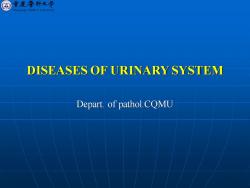
重蹇等科大学 ongging Medical University DISEASES OF URINARY SYSTEM Depart.of pathol.CQMU
DISEASES OF URINARY SYSTEM Depart. of pathol.CQMU
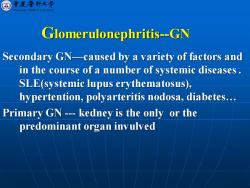
倒重麦普种大号 gqing Med山eal Univers Glomerulonephritis-GN Secondary GN-caused by a variety of factors and in the course of a number of systemic diseases. SLE(systemic lupus erythematosus), hypertention,polyarteritis nodosa,diabetes. Primary GN-kedney is the only or the predominant organ invulved
Glomerulonephritis-GN Secondary GN—caused by a variety of factors and in the course of a number of systemic diseases . SLE(systemic lupus erythematosus), hypertention, polyarteritis nodosa, diabetes. Primary GN - kedney is the only or the predominant organ invulved
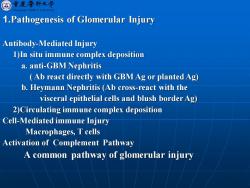
1.Pathogenesis of Glomerular Injury Antibody-Mediated Injury 1)In situ immune complex deposition a.anti-GBM Nephritis (Ab react directly with GBM Ag or planted Ag) b.Heymann Nephritis (Ab cross-react with the visceral epithelial cells and blush border Ag) 2)Circulating immune complex deposition Cell-Mediated immune Injury Macrophages,T cells Activation of Complement Pathway A common pathway of glomerular injury
1.Pathogenesis of Glomerular Injury Antibody-Mediated Injury 1)In situ immune complex deposition a. anti-GBM Nephritis ( Ab react directly with GBM Ag or planted Ag) b. Heymann Nephritis (Ab cross-react with the visceral epithelial cells and blush border Ag) 2)Circulating immune complex deposition Cell-Mediated immune Injury Macrophages, T cells Activation of Complement Pathway A common pathway of glomerular injury
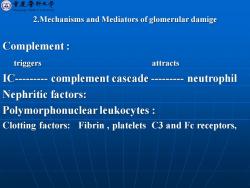
重蹇暗科大图 2.Mechanisms and Mediators of glomerular damige Complement triggers attracts IC-complement cascade neutrophil Nephritic factors: Polymorphonuclear leukocytes Clotting factors:Fibrin,platelets C3 and Fc receptors
2.Mechanisms and Mediators of glomerular damige Complement : triggers attracts IC- complement cascade - neutrophil Nephritic factors: Polymorphonuclear leukocytes : Clotting factors: Fibrin , platelets C3 and Fc receptors
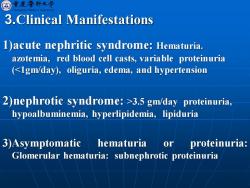
重蹇等科大学 3.Clinical Manifestations 1)acute nephritic syndrome:Hematuria. azotemia,red blood cell casts,variable proteinuria (3.5 gm/day proteinuria, hypoalbuminemia,hyperlipidemia,lipiduria 3)Asymptomatic hematuria or proteinuria; Glomerular hematuria:subnephrotic proteinuria
3.Clinical Manifestations 1)acute nephritic syndrome: Hematuria. azotemia, red blood cell casts, variable proteinuria (3.5 gm/day proteinuria, hypoalbuminemia, hyperlipidemia, lipiduria 3)Asymptomatic hematuria or proteinuria: Glomerular hematuria: subnephrotic proteinuria

圈重麦晋行大学 gqing Med山eal Univers 4)rapidly progressive nephritic syndrome: Acute nephritis,proteinuria,and acute renal failure 5)chronic nephritic syndrome:Azotemia uremia progressing for years
4)rapidly progressive nephritic syndrome: Acute nephritis, proteinuria, and acute renal failure 5)chronic nephritic syndrome: Azotemia uremia progressing for years
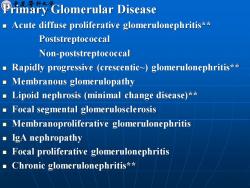
Primary Glomerular Disease Acute diffuse proliferative glomerulonephritis** Poststreptococcal Non-poststreptococcal Rapidly progressive (crescentic~)glomerulonephritis** Membranous glomerulopathy Lipoid nephrosis (minimal change disease)** Focal segmental glomerulosclerosis Membranoproliferative glomerulonephritis ▣IgA nephropathy Focal proliferative glomerulonephritis Chronic glomerulonephritis**
Primary Glomerular Disease ◼ Acute diffuse proliferative glomerulonephritis** Poststreptococcal Non-poststreptococcal ◼ Rapidly progressive (crescentic~) glomerulonephritis** ◼ Membranous glomerulopathy ◼ Lipoid nephrosis (minimal change disease)** ◼ Focal segmental glomerulosclerosis ◼ Membranoproliferative glomerulonephritis ◼ IgA nephropathy ◼ Focal proliferative glomerulonephritis ◼ Chronic glomerulonephritis**
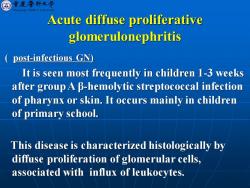
重蹇普科大学 Acute diffuse proliferative glomerulonephritis post-infectious GN) It is seen most frequently in children 1-3 weeks after group A B-hemolytic streptococcal infection of pharynx or skin.It occurs mainly in children of primary school. This disease is characterized histologically by diffuse proliferation of glomerular cells, associated with influx of leukocytes
Acute diffuse proliferative glomerulonephritis ( post-infectious GN) It is seen most frequently in children 1-3 weeks after group A β-hemolytic streptococcal infection of pharynx or skin. It occurs mainly in children of primary school. This disease is characterized histologically by diffuse proliferation of glomerular cells, associated with influx of leukocytes
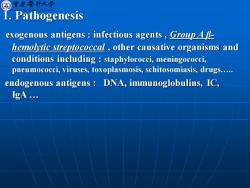
霸重走等科大导 I.Pathogenesis exogenous antigens infectious agents Group AB- hemolytic streptococcal,other causative organisms and conditions including staphylococci,meningococci, pneumococci,viruses,toxoplasmosis,schitosomiasis,drugs. endogenous antigens DNA,immunoglobulins,IC, IgA
1. Pathogenesis exogenous antigens : infectious agents , Group A β- hemolytic streptococcal , other causative organisms and conditions including : staphylococci, meningococci, pneumococci, viruses, toxoplasmosis, schitosomiasis, drugs. endogenous antigens : DNA, immunoglobulins, IC, IgA
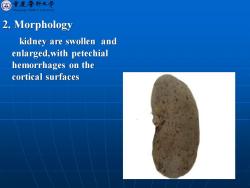
圈重麦晋行大学 gqing Med山l Universits 2.Morphology kidney are swollen and enlarged,with petechial hemorrhages on the cortical surfaces
2. Morphology kidney are swollen and enlarged,with petechial hemorrhages on the cortical surfaces
按次数下载不扣除下载券;
注册用户24小时内重复下载只扣除一次;
顺序:VIP每日次数-->可用次数-->下载券;
- 重庆医科大学:《病理学》课程教学课件(PPT讲稿)endocrine system disease_2.ppt
- 重庆医科大学:《病理学》课程教学课件(PPT讲稿)endocrine system disease_1.ppt
- 重庆医科大学:《病理学》课程教学课件(PPT讲稿)female genital system disease.ppt
- 重庆医科大学:《病理学》课程教学课件(PPT讲稿)Epidemic Meningitis.ppt
- 重庆医科大学:《病理学》课程教学课件(PPT讲稿)infection diseases.ppt
- 重庆医科大学:《病理学》课程教学资源(授课教案)肿瘤.doc
- 重庆医科大学:《病理学》课程教学资源(授课教案)炎症.doc
- 重庆医科大学:《病理学》课程教学资源(授课教案)局部血液循环障碍.doc
- 重庆医科大学:《病理学》课程教学资源(授课教案)细胞及组织的适应、损伤及修复.doc
- 重庆医科大学:《病理学》课程教学资源(授课教案)泌尿系统疾病.doc
- 重庆医科大学:《病理学》课程教学资源(授课教案)消化系统疾病.doc
- 重庆医科大学:《病理学》课程教学资源(授课教案)呼吸系统疾病.doc
- 重庆医科大学:《病理学》课程教学资源(授课教案)心血管系统疾病.doc
- 重庆医科大学:《病理学》课程教学资源(授课教案)神经系统疾病.doc
- 重庆医科大学:《病理学》课程教学资源(授课教案)女性生殖系统疾病.doc
- 重庆医科大学:《病理学》课程教学资源(授课教案)传染和寄生虫病.doc
- 重庆医科大学:《病理学》课程教学资源(授课教案)内分泌系统疾病.doc
- 重庆医科大学:《病理学》课程教学资源(授课教案)inflammation.doc
- 重庆医科大学:《病理学》课程教学资源(授课教案)Introduction and hemodynamic rearangment.doc
- 重庆医科大学:《病理学》课程教学资源(授课教案)tumor.doc
- 重庆医科大学:《病理学》课程教学课件(PPT讲稿)Diseases of the Respiratory System.ppt
- 重庆医科大学:《病理学》课程教学课件(PPT讲稿)cardiovascular system disease.ppt
- 重庆医科大学:《病理学》课程教学课件(PPT讲稿)lymphoma.ppt
- 重庆医科大学:《病理学》课程教学课件(PPT讲稿)alimentary system disease.ppt
- 重庆医科大学:《病理学》课程教学课件(PPT讲稿)inflammation.ppt
- 重庆医科大学:《病理学》课程教学课件(PPT讲稿)tissue repair.ppt
- 重庆医科大学:《病理学》课程教学课件(PPT讲稿)Cell injury.ppt
- 重庆医科大学:《病理学》课程教学课件(PPT讲稿)disorder of blood flow.ppt
- 重庆医科大学:《病理学》课程教学课件(PPT讲稿)introduction.ppt
- 重庆医科大学:《病理学》课程教学课件(PPT讲稿)Tumor.ppt
- 重庆医科大学:《病理学》课程教学课件(PPT讲稿)女性生殖系统疾病(disease of female reproductive system and breast).ppt
- 重庆医科大学:《病理学》课程教学课件(PPT讲稿)神经系统疾病(Diseases of the CNS).ppt
- 重庆医科大学:《病理学》课程教学课件(PPT讲稿)传染病与寄生虫病(infectious desease and parasitosis).ppt
- 重庆医科大学:《病理学》课程教学课件(PPT讲稿)消化系统疾病 Digestive system disease.ppt
- 重庆医科大学:《病理学》课程教学课件(PPT讲稿)内分泌系统疾病.ppt
- 重庆医科大学:《病理学》课程教学课件(PPT讲稿)泌尿系统疾病 Diseases of urinary system.ppt
- 重庆医科大学:《病理学》课程教学课件(PPT讲稿)呼吸系统疾病.ppt
- 重庆医科大学:《病理学》课程教学课件(PPT讲稿)心血管疾病 Diseases of Cardiovascular system.ppt
- 重庆医科大学:《病理学》课程教学课件(PPT讲稿)炎症 inflammation.ppt
- 重庆医科大学:《病理学》课程教学课件(PPT讲稿)淋巴造血系统(malignant lymphoma).ppt
